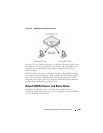
1266 Configuring DHCPv6 Server and Relay Settings
What Is a DHCPv6 Pool?
DHCPv6 pools are used to specify information for DHCPv6 server to
distribute to DHCPv6 clients. These pools are shared between multiple
interfaces over which DHCPv6 server capabilities are configured.
What Is a Stateless Server?
DHCPv6 incorporates the notion of the
stateless
server, where DHCPv6 is
not used for IP address assignment to a client; rather, it provides other
networking information such as DNS or NTP information. The stateless
server behavior is described by RFC 3736 [7], which simply contains
descriptions of the portions of RFC 3315 that are necessary for stateless server
behavior. In order for a router to drive a DHCPv6 client to utilize stateless
DHCPv6, the
other stateful configuration
option must be configured for
neighbor discovery on the corresponding IPv6 router interface. This, in turn,
causes DHCPv6 clients to send the DHCPv6 Information Request message
in response. A DHCPv6 server then responds by providing only networking
definitions such as DNS domain name and server definitions, NTP server
definitions, or SIP definitions.
What Is the DHCPv6 Relay Agent Information Option?
The DHCPv6 Relay Agent Information Option allows for various sub-options
to be attached to messages that are being relayed by the local router to a
DHCPv6 server. The DHCPv6+ server may in turn use this information in
determining an address to assign to a DHCPv6 client.RFC 3315 also
describes DHCPv6 Relay Agent interactions, which are very much like
DHCPv4 Relay Agents. Additionally, there is a DHCPv6 Relay Agent Option
described in RFC 4649, which employs very similar capabilities as those
described by the DHCPv4 Relay Agent Option in RFC 2132.
What Is a Prefix Delegation?
With the larger address space inherent to IPv6, addresses within a network
can be allocated more effectively in a hierarchical fashion. DHCPv6
introduces the notion of prefix delegation as described in RFC 3633 as a way
for routers to centralize and delegate IP address assignment. Figure 39-1
depicts a typical network scenario where prefix delegation is used.


















